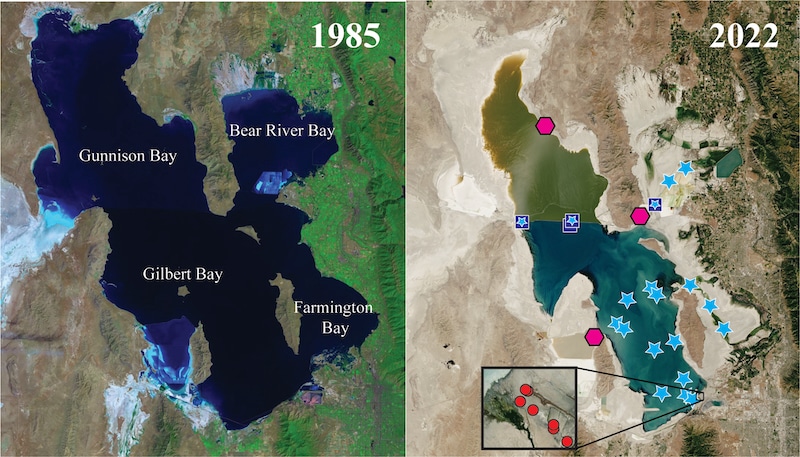This post was originally published on Eco Watch
New research has revealed that as the lake bed of the Great Salt Lake dries out, it’s becoming a greater source of greenhouse gas emissions.
According to a study published in the journal One Earth, the dry parts of the Great Salt Lake in Utah contributed about 4.1 million tons of carbon emissions in 2020 alone, revealing that this lake bed and other drying lake beds could be contributing much more greenhouse gas emissions than expected.
The study revealed that the emissions from the Great Salt Lake led to around a 7% increase in anthropogenic greenhouse gas emissions for the state of Utah in 2020.
“Human-caused desiccation of Great Salt Lake is exposing huge areas of lake bed and releasing massive quantities of greenhouse gases into the atmosphere,” Soren Brothers, lead researcher of the study and the Allan and Helaine Shiff Curator of Climate Change at the Royal Ontario Museum, said in a statement. “The significance of lake desiccation as a driver of climate change needs to be addressed in greater detail and considered in climate change mitigation and watershed planning.”
Historic full lake levels and bays (1985; Landsat) and recent low levels (2022, NASA Earth Observatory). One Earth
The researchers measured emissions of carbon dioxide and methane in the dry areas of the lake from April to November, then adjusted the measurements after comparing the totals to the natural aquatic emissions. This allowed the team to determine how much of the emissions from the drying lake bed could be contributed to human activity.
Additionally, the results showed a strong link between increasing emissions from the lake bed and higher temperatures.
According to the Royal Ontario Museum, water levels of the Great Salt Lake varies from year to year, but levels have been declining in recent years, even reaching a record low in 2022. As The Guardian reported, the lake has lost about 73% of its water, in part driven by drought and global warming. Human activity, including drawing water for agricultural and residential use, have also contributed to declining water levels in the Great Salt Lake.
The Great Salt Lake spans about 1,700 square miles and is the largest saltwater lake in the western hemisphere. As its water levels decline and concerns rise over emissions from the dry lake bed, there are other worries over a drying saline lake, too. In 2022, Utah officials warned about toxic air pollution that could be emitted from the lake bed as it dried out.
“I think the impacts on air quality, the impacts on migratory birds and other wildlife are maybe more pressing, locally,” Brothers told The Guardian. “But especially at a time when we are all trying to find ways to reduce our carbon footprint, as Salt Lake City is working to reduce emissions, this desiccating lake is adding some of that back.”
The study authors noted that greenhouse gas emissions from dry, exposed lake beds should be considered when deciding ways to improve water management and reduce anthropogenic greenhouse gas emissions.
The post Great Salt Lake Is Releasing Millions of Tons of Carbon Emissions, Study Finds appeared first on EcoWatch.





0 Comments